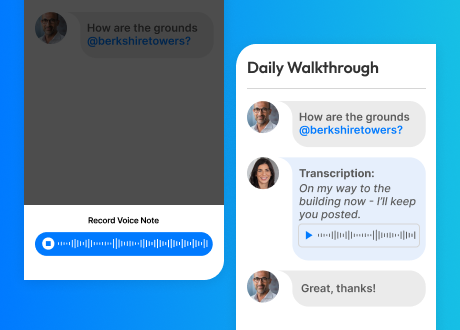Microsoft Teams is a chat application that comes along with the Microsoft product suite – but does it streamline communication and reduce email overload for property management employees? Consider the facts about companies that use Teams for communication: the average regional manager still gets hundreds of emails per day. Executives spend hours searching for a specific file or photo across various platforms. On-site staff default to using group text chats for sensitive conversations.
With all this in mind, it’s not surprising that property management companies often describe their communication process as broken, painful, and chaotic: a mess of emails, text messages, and Teams chats that are disconnected and impossible to search. Microsoft Teams is supposed to solve these challenges, but ends up just adding to the communication chaos.
Property Management is Unique – and Microsoft Teams is Generic
Many property management organizations think that because MS Teams comes along with their email platform, they’ve got the “team communication” box checked off. But using chat applications like Microsoft Teams isn’t a workable solution and often leads to more disjointed conversations, because the generic features of MS Teams aren’t created or optimized for the usual property management functions and workflow.
Here’s what happens when a typical property management team tries to use MS Teams to run their properties:
- They find that Teams isn’t built for the world of property management. MS Teams is designed to be generic, and apply to multiple industries at once – but it doesn’t have the concepts of properties, units, vendors, etc. that property management revolves around. Teams may be fine for occasional video calls, but when it comes to property-level teams needing to communicate back and forth with HQ departments, the lack of property management specificity creates more headaches.
- On-site staff members rarely adopt MS Teams for chat, for two main reasons: one, because Teams is not optimized for a mobile, on-the-go experience, and two, because many on-site team members don’t even have a dedicated company email address. As a result, Microsoft Teams ends up being primarily used as a corporate office tool. If you really want to solve problems faster, you need to have a platform that gets adopted across your entire organization, from the site level to the C-suite. After all, so much happens at the property level that needs to make its way back to the office team members.
- Microsoft Teams doesn’t organize information in an accessible, intuitive way that makes sense for property management teams. When you search your PMS, everything is organized by property and unit. When searching Teams for a file or photo associated with a particular property, or unit, the only option is a universal search across endless chats. In property management, fast recall of important unit-level conversations is critically important – and with no streamlined filing system for conversations, searching in Teams usually turns up dead ends.
- Property management suppliers and vendors – painters, contractors, security companies, elevator consultants, etc. – are an extension of the modern PM team, and require constant communication to coordinate on-site visits and work. But in MS Teams, there’s no way to integrate & communicate with third-party vendors, making it unusable for a major chunk of the work that PM teams do everyday.
- Microsoft Teams doesn’t integrate with the rest of the property management tech stack. Across nearly every aspect of their workflow – from leasing to accounting to maintenance – PM companies use specialized software that has been built for the unique needs of the industry. All of this PM-specific software should be underpinned by a communications platform that integrates and operates alongside it – not a generic chat tool that isn’t built for owners and managers.
For all these reasons, Teams is, at best, lightly used among a subsection of property management employees and, at worst, another factor in the mess of communication that companies experience daily. The result? Disjointed, chaotic communication that slows down decision-making and issue resolution.
How Synco Stacks Up Against Microsoft Teams
“Take one look at Synco and you immediately see what you’ve been missing in Microsoft Teams. Synco is built for us – built for the property management professional. It makes it easy to find conversations, information and documents – by property, by unit, etc. By comparison, Teams is just a jumbled mess of disorganized ‘chats.'”
– Mario Gaztambide, Senior Managing Director, Residential Properties, LeFrak
Don’t let the limitations of Microsoft Teams prevent your property management team from communicating and collaborating effectively. Here’s how Synco stacks up against Microsoft Teams as a communication platform:
- Synco was built from the ground up with property management companies’ needs in mind. Unlike Teams, Synco feature development is solely focused on the unique needs of the property management industry.
- On-site property staff actually enjoy using Synco. They find it just as easy as texting or WhatsApp, but built for the fast-paced work they do, like quick message creation and photo capture, one click to message favorite groups or contacts, and built-in message translation.
- Where Microsoft Teams is just an endless list of chats, Synco is intuitively organized how property management teams work, via a universal filing system for all conversations, called Tagging. Tags are standardized keyword labels for properties, units, projects, etc. that unify organization across your company: once a team member tags a conversation, it’s labeled for everyone – and easy to find later.
- Synco offers a seamless way for external parties – suppliers, partners, vendors, etc. – to interact with your property management team. External Party Access allows you to add an outside party to a Synco conversation, and they can respond without ever leaving their normal email workflow. Your team keeps conversations centralized in one place, and keeps moving quickly.
- Because it’s built for the property management industry, Synco enhances the value of your PM tech stack. By connecting to your other applications, Synco brings alerts and reports (that would otherwise just create more email for you) directly to your Synco inbox.
Ready to level up from Teams, and empower your company to come together on one centralized, easy-to-use messaging platform? Get a Personalized Demo of Synco Today



